#cuban radio stations
Explore tagged Tumblr posts
Text
Radio Cuba FM & AM + Radio Online - (Radio Android Application 🇨🇺📻)
Cuba is a country with a rich and diverse radio landscape. From national broadcasters to local community stations, there are a wide range of options for listeners across the country.
One of the most well-known radio stations in Cuba is Radio Rebelde. Established in 1958, Radio Rebelde played a key role in the Cuban Revolution and remains a popular choice for those seeking news, current affairs, and political commentary.
Another major player in the Cuban radio landscape is Radio Havana Cuba. This international broadcaster provides news and analysis from a Cuban perspective to listeners around the world, and is available in a variety of languages, including English, Spanish, and French.
In addition to these national broadcasters, Cuba is also home to a thriving community radio sector. Community radio stations are run by volunteers, and provide a platform for local voices and perspectives. These stations often specialize in niche music genres or cultural programming, and are a great way to discover new artists and perspectives.
Some popular community radio stations in Cuba include Radio Progreso, which focuses on social justice and community issues, and Radio Taino, which plays traditional Cuban music and features local cultural programming.
No matter what your interests or preferences, there is sure to be a radio station in Cuba that suits your needs. With a diverse range of broadcasters and programming, Cuban radio is a vibrant and dynamic part of the country's media landscape. So why not tune in today and discover what the Cuban airwaves have to offer?
SO, DOWNLOAD NOW APP!! 🔽🔽
✔✔ GOOGLE PLAY STORE: ▶ https://play.google.com/store/apps/details?id=com.alexto.radiosdecubaenvivofmyam
✔✔ AMAZON APP STORE: ▶ http://www.amazon.com/gp/mas/dl/android?p=com.alexto.radiosdecubaenvivofmyam
✔✔ SAMSUNG GALAXY STORE: ▶http://galaxystore.samsung.com/detail/com.alexto.radiosdecubaenvivofmyam
#radio#internet radio#radiostation#radio cuba#cuban radio stations#radio cuba fm#radio cuba android#android#play store#amazon app store#samsung galaxy store
0 notes
Text
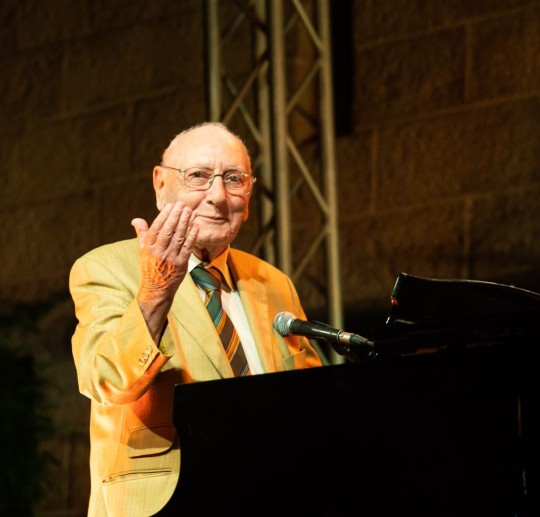
The musician Maurice el Médioni, who has died aged 95, provided a reminder that there was a time – in the period between the second world war and Algerian independence in 1962 – when Muslim and Jewish musicians worked together in Algeria to transform the country’s popular music.
He was a pianist who could play, and blend together, almost any musical style. His left hand might pump out stomping boogie rhythms while his right hand played Arabic or Andalusian styles. He could switch from French chanson and cabaret to Latin themes, and he played a key role in the development of the Algerian styles chaabi and raï.
El Médioni described his early life in the Algerian port city of Oran as “playing in bars and at Arabic marriages or Jewish weddings or playing in a big chaabi orchestra for the Algiers radio station. I started out playing boogie-woogie that I learned from the Americans, then Latin music, flamenco and Andalusian music. I was one of the first to do that and brought it into Arabic music, and now they love it.”
He was a star in Algeria in the 1950s, but then came the Algerian war, independence and the large-scale exodus of the Jewish population. El Médioni left for Israel in 1961, but when he realised that many of his exiled musician friends had moved to Paris he decided to join them. There he worked as a tailor by day and a musician by night – a lifestyle he continued when he moved to Marseille in 1967.
After decades in the musical wilderness, El Médioni eventually built an international reputation when in his 60s. The French producer Francis Falceto (creator of the Éthiopiques series) heard a cassette of El Médioni’s music and played it to the British musician and producer Ben Mandelson. Mandelson produced a recording session in Berlin, with El Médioni playing alongside some of his own musician friends and some British musicians, and the resulting album, Café Oran (1996), introduced his unique piano style to a new audience.
He followed with the album PianOriental (2000) and in the same year played at the Soul of Algeria concert at the Barbican in London, accompanying his old friend the Jewish Algerian singer Lili Boniche, in a line-up that included the Algerian “grandmother of raï”, Cheikha Rimitti.
In 2003 he opened for the British band Oi Va Voi and then joined them for the encores at shows at the ICA in London, and in Moscow and Los Angeles, and in 2006 released Descarga Oriental with the Cuban percussionist Roberto Rodriguez. Recorded in New York, the album was a reminder that Latin styles were among those he had loved and learned back in Oran. The album won a BBC Radio 3 World Music award.
The following year El Médioni played a major role in the El Gusto project, which involved an album, a film and a series of concerts that reunited Muslim and Jewish musicians from Algeria. He had declined to appear at a concert in Algeria, saying it was “not the right time” to return, but starred in an emotional show in Marseille that ended with a rousing version of the Algerian favourite Ya Rayah. In 2008 there was a further reunion with Algerian musicians as he opened for Khaled, raï’s biggest international star, at the Barbican; he had earlier played on Khaled’s 2004 album Ya-Rayi.
In 2011, and by now in his 80s, El Médioni and his wife, Juliette (nee Amsallem), whom he married in 1953, moved to Israel to live close to their children. He continued to record and perform, working with the Orchestra Ashkelon and the singer Neta Elkayam, and was a major influence on young Israeli pianists. He returned to London in 2012 to play with the Iraqi oud player Khyam Allami.
Born in Oran, in French Algeria, Maurice was one of four siblings brought up by their mother, Fany, following the death of their father, Jacob. Jacob had run the Café Saoud in the city’s Jewish quarter along with his brother, Messaoud El Médioni, the renowned musician better known as Saoud l’Oranais. Maurice attended the Ecole St André, and started to learn the piano when he was nine, playing by ear and listening to the musicians who gathered at the cafe.
He incorporated anything that he heard into his playing, learning Latin, jazz and boogie-woogie from the black American GIs who arrived in the city after the liberation of Oran in 1942. He played in clubs popular with the soldiers, and made sure his audience heard the music they wanted. He also composed and played for the big names of the Jewish Algerian cabaret scene, including Boniche and Line Monty. He had been persuaded by his mother to follow a career as a tailor, but music was his passion.
In 2017 he published his memoir From Oran to Marseilles (1936-1990) with help from his British followers. The preface was by Mandelson, the foreword, translation and interviews were by Jonathan Walton (a former member of Oi Va Voi, who uses the name Lemez Lovas as a musician), and the editor was the broadcaster and musician Max Reinhardt, who described him as “charming, open-hearted, wise and witty … a compulsive musician who couldn’t wait to get near a keyboard”.
Juliette died in 2022. El Médioni is survived by his children, Yacov, Marilyne and Michael, and five grandchildren, Jeremie, Barbara, Benjamin, Nourit and Emmanuel.
🔔 Maurice el Médioni, musician and songwriter, born 18 October 1928; died 25 March 2024
Daily inspiration. Discover more photos at Just for Books…?
5 notes
·
View notes
Text
I forgot all about this
First "Underground Music" Program Heard Far Away into Cuba
Once upon a time in 1966 there was a 50,000 watt AM radio station in Little Rock, AR called KAAY and they ran a late night show called Beaker Street, which featured a blend of progressive rock, blues, and psychedelic music from the 1960s and 1970s. Beaker Street pre-dated the FM radio boom of the mid-1970s and foretold the rise of album-oriented Rock and Classic rock formats.
In 1966, Beaker Street hosted by Clyde Clifford was the first underground music program broadcast regularly on a commercial AM radio station in the central US. Over the years, Beaker Street became an iconic program and is widely regarded as a pioneer in the field of progressive rock radio. For fans of Beaker Street, many album cuts became favorites over the years, including songs which were generally not available on either 45-rpm records or LP albums.
In early 1967 Beaker Street was a staple for adherents to the burgeoning underground communities in the upper Mid-West especially in Des Moines, Iowa, where it was the only access to Dr. Demento and Firesign Theatre. The strong nighttime signal of 50,000 watt, clear channel KAAY meant that it was possible to regularly listen to the station's nighttime programming in a wide area of the midwest and south.
Beaker Street attracted a legion of fans across the Midwest with its pioneering format, which featured long album cuts from rock artists who otherwise would not get commercial radio airplay outside of large cities with freeform or progressive rock stations. KAAY's late-night "footprint" gained fans as far west as Wyoming and Montana, north to the Dakotas and Manitoba and south as far as New Orleans and into Florida. This strong broadcast signal enabled Beaker Street to deliver the music of the late 1960s counterculture to many smaller cities and towns in America, where such music could not otherwise be heard over the air waves.
The KAAY nighttime signal was so strong that young people in Havana City and in other places in Cuba were able to receive it clearly. In the late 1970s, music sung in English was restricted by the Communist Government. Cuban radio stations were allowed to devote only about 20% of their time broadcasting music sung in English, so many young people used to listen to American radio stations as a response to that limitation, and the KAAY was one of the most popular.
Radio theater also made a comeback on Beaker Street, in half-hour or hour-long segments called Beaker Theatre; sometimes utilizing serious (and occasionally not-so serious) re-workings of old radio serial scripts, voiced by the Beaker Players; sometime playing the recordings of the comedy group Firesign Theatre, especially the "Nick Danger - Third Eye" series of skits. During the run of Beaker Street, the Firesign Theatre actually made several live appearances on the show.
Clyde Clifford continued to host Beaker Street until his retirement in 2018, after which the program was temporarily suspended. Today, Beaker Street continues to be a beloved program for music fans in the Little Rock area and beyond, and its legacy as a groundbreaking radio show remains an important part of the history of progressive rock and radio broadcasting.

4 notes
·
View notes
Text
Free all political prisoners! Free Mumia Abu Jamal! Free them all!
Is it just me or do a lot of people believe the myth that we here in the US are a free nation and all that good government nonsense we are propagandized to believe is what goes? If you question this or do anything outside the capitalist system you are labeled “crazy” or “insane”, am I correct? Anytime there is resistance to the capitalist system it wears you down so you can give up, surrender, and even sell out your movement or cause.
However, there is some hope. There are people that are becoming conscious enough to think critically about their situation. I remember when I was in high school and learning about Dr. Ernesto Che Guevara. Then going on to learn about the Cuban revolution. Somewhere along that time in my learning into college I came across La Raza Unida Party, the Brown Berets, the Black Panther Party and as I did some more research, I came to learn that these organizations had newspapers and ran other survival programs for the community. It was not just about carrying a gun and being all macho, which unfortunately those contradictions would come to surface and overshadow the real work that needed to get done. Nonetheless, our communities saw a problem that needed to be addressed, they came together to do something about it, and when we were making progress becoming independent of the system, it sabotaged that work so we wouldn’t come together.
There were assassinations, car bombings, false letters written forged with signatures sent around, and many other tactics to destroy our work and our spirit. Many became isolated, were facing extreme charges, and locked away as political prisoners. Have you ever heard of Mumia Abu Jamal? Leanard Peltier? It all depends on who you ask, but many people do not know who they are, their contributions to society, or the many other political prisoners that exist today or who now have transitioned on to be with the ancestors. You can learn more about Mumia Abu Jamal and his case here: Mumia Abu-Jamal – Prison Radio

I have been a long-time supporter of prisonradio.org and volunteer with them transcribing commentaries by correspondents inside that are incarcerated. We are currently looking for radio stations, journalists, tv stations, podcasters, and anyone who can publish and/or broadcast commentaries and articles by correspondents, in particular by Mumia Abu Jamal. Feel free to reach out to me if you have any recommendations or suggestions. Feel free to share commentaries and articles on your social media. You can learn more about Prison Radio, listen, and read correspondent commentaries here: About – Prison Radio

2 notes
·
View notes
Text
For those who live in New Jersey and those who visit . . . .
New Jersey is a peninsula.
Highlands, New Jersey has the highest elevation along the entire eastern seaboard, from Maine to Florida.
New Jersey is the only state where all of its counties are classified as metropolitan areas.
New Jersey has more race horses than Kentucky.
New Jersey has more Cubans in Union City (1 sq. mi.) than Havana, Cuba.
New Jersey has the densest system of highways and railroads in the US.
New Jersey has the highest cost of living.
New Jersey has the highest cost of auto insurance.
New Jersey has the highest property taxes in the nation.
New Jersey has the most diners in the world and is sometimes referred to as the "Diner Capital of the World."
New Jersey is home to the original Mystery Pork Parts Club (not Spam): Taylor Ham or Pork Roll.
Home to the less mysterious but the best Italian hot dogs and Italian sausage w/peppers and onions.
North Jersey has the most shopping malls in one area in the world, with seven major shopping malls in a 25 square mile radius.
The Passaic River was the site of the first submarine ride by inventor John P. Holland .
New Jersey has 50+ resort cities & towns; some of the nation's most famous: Asbury Park, Wildwood, Atlantic City, Seaside Heights, Cape May.
New Jersey has the most stringent testing along its coastline for water quality control than any other seaboard state in the entire country.
New Jersey is a leading technology & industrial state and is the largest chemical producing state in the nation when you include pharmaceuticals.
Jersey tomatoes are known the world over as being the best you can buy.
New Jersey is the world leader in blueberry and cranberry production (and here you thought Massachusetts?)
Here's to New Jersey - the toast of the country! In 1642, the first brewery in America, opened in Hoboken.
New Jersey rocks! The famous Les Paul invented the first solid body electric guitar in Mahwah, in 1940.
New Jersey is a major seaport state with the largest seaport in the US, located in Elizabeth. Nearly 80 percent of what our nation imports comes through Elizabeth Seaport first.
New Jersey is home to one of the nation's busiest airports (in Newark), Liberty International.
George Washington slept there.
Several important Revolutionary War battles were fought on New Jersey soil, led by General George Washington.
The light bulb, phonograph (record player), and motion picture projector, were invented by Thomas Edison in his Menlo Park, NJ, laboratory
Jersey also boasts the first town lit by incandescent bulbs. The first seaplane was built in Keyport , NJ.
The first airmail (to Chicago) was started from Keyport, NJ.
The first phonograph records were made in Camden, NJ
New Jersey was home to the Miss America Pageant held in Atlantic City.
The game Monopoly, played all over the world, named the streets on its playing board after the actual streets in Atlantic City. And, Atlantic City has the longest boardwalk in the world, not to mention salt water taffy. ( Now made in Pennsylvania)..
New Jersey has the largest petroleum containment area outside of the Middle East countries.
The first Indian reservation was in New Jersey, in the Watchung Mountains
New Jersey has the tallest water-tower in the world. (Union, NJ!!!)
New Jersey had the first medical center, in Jersey City
The Pulaski Sky Way, from Jersey City to Newark, was the first skyway highway.
New Jersey built the first tunnel under a river, the Hudson (Holland Tunnel).
The first baseball game was played in Hoboken, NJ, which is also the birthplace of Frank Sinatra.
The first intercollegiate football game was played in New Brunswick in 1889 (Rutgers College played Princeton).
The first drive-in movie theater was opened in Camden, NJ, (but they're all gone now!).
New Jersey is home to both of "NEW YORK'S" pro football teams!
The first radio station and broadcast was in Paterson, NJ.
The first FM radio broadcast was made from Alpine, NJ, by Maj. Thomas Armstrong.
All New Jersey natives: Sal Martorano, Jack Nicholson, Bruce Springsteen, Bon Jovi, Jason Alexander, Queen Latifah, Susan Sarandon, Connie Francis, Shaq, Judy Blume, Aaron Burr, Joan Robertson, Ken Kross, Dionne Warwick, Sarah Vaughn, Budd Abbott, Lou Costello, Alan Ginsberg, Norman Mailer, Marilynn McCoo, Flip Wilson, Alexander Hamilton, Zack Braff Whitney Houston, Eddie Money, Linda McElroy, Eileen Donnelly, Grover Cleveland, Woodrow Wilson, Walt Whitman, Jerry Lewis, Tom Cruise, Joyce Kilmer, Bruce Willis, Caesar Romero, Lauryn Hill, Ice-T, Nick Adams, Nathan Lane, Sandra Dee, Danny DeVito, Richard Conti, Joe Pesci, Joe Piscopo, Joe DePasquale, Robert Blake, John Forsythe, Meryl Streep, Loretta Swit, Norman Lloyd, Paul Simon, Jerry Herman, Gorden McCrae, Kevin Spacey, John Travolta, Phyllis Newman, Anne Morrow Lindbergh, Eva Marie Saint, Elisabeth Shue, Zebulon Pike, James Fennimore Cooper, Admiral Wm.Halsey,Jr.,Norman Schwarzkopf, Dave Thomas (Wendy's), William Carlos Williams, Ray Liotta, Robert Wuhl, Bob Reyers, Paul Robeson, Ernie Kovacs, Joseph Macchia, Kelly Ripa, and Francis Albert Sinatra and "Uncle Floyd" Vivino.
The Great Falls in Paterson, on the Passaic River, is the 2nd highest waterfall on the East Coast of the US.
You know you're from Jersey when . . . .
You don't think of fruit when people mention "The Oranges." You know that it's called Great Adventure, not Six Flags. A good, quick breakfast is a hard roll with butter. You've known the way to Seaside Heights since you were seven. You know that the state isn't one big oil refinery. At least three people in your family still love Bruce Springsteen, and you know the town Jon Bon Jovi is from. You know what a "jug handle" is. You know that WaWa is a convenience store. You know that the state isn't all farmland. You know that there are no "beaches" in New Jersey--there's the shore--and you don't go "to the shore," you go "down the shore." And when you are there, you're not "at the shore"; you are "down the shore." You know how to properly negotiate a circle. You knew that the last sentence had to do with driving. You know that this is the only "New" state that doesn't require "New" to identify it (try . . Mexico . . . York ..! . . Hampshire-- doesn't work, does it?). You know that a "White Castle" is the name of BOTH a fast food chain AND a fast food sandwich. You consider putting mayo on a corned beef sandwich a sacrilege. You don't think "What exit?" is very funny. You know that people from the 609 area code are "a little different." Yes they are! You know that no respectable New Jerseyan goes to Princeton--that's for out-of-staters. You live within 20 minutes of at least three different malls. You refer to all highways and interstates by their numbers. Every year you have at least one kid in your class named Tony. You know the location of every clip shown in the Sopranos opening credits. You've gotten on the wrong highway trying to get out of the mall. You know that people from North Jersey go to Seaside Heights, and people from Central Jersey go to LBI, and people from South Jersey go to Wildwood. It can be no other way. You weren't raised in New Jersey--you were raised in either North Jersey, Central Jersey or South Jersey. You don't consider Camden to actually be part of the state You remember the stores Korvette's, Two Guys, Rickel's, Channel, Bamberger's and Orbach's. You also remember Palisades Amusement Park. You've had a boardwalk cheese steak and vinegar fries. You start planning for Memorial Day weekend in February.
And finally . .
You've NEVER, NEVER NEVER, EVER pumped your own gas.
(Copied from a friend)
4 notes
·
View notes
Text
CURTAIN UP!
Lucy On Stage ~ Act 1
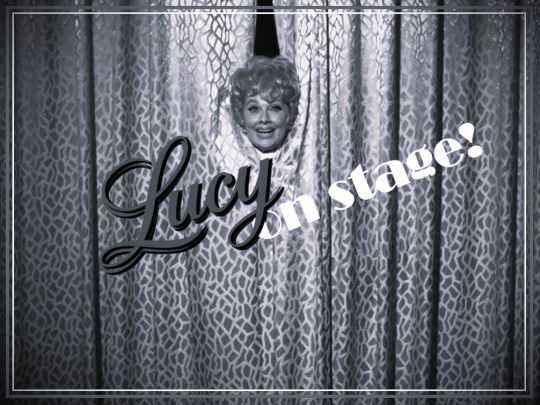
Lucille Ball’s dream was always to appear on Broadway. That dream didn’t become reality until 1960. In the meantime, if Lucy couldn’t go to Broadway, Broadway would come to Lucy - on her radio and television shows!
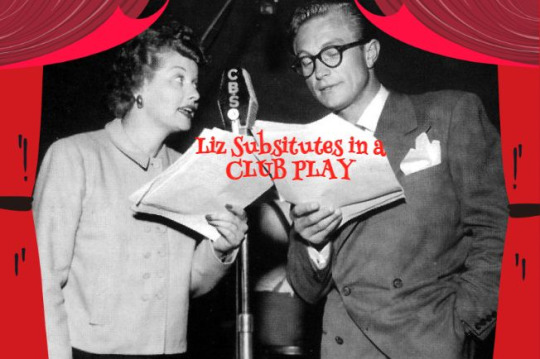
“The Milkmaid’s Dilemma or The Lady’s Not For Turning”
“Liz Substitutes in a Club Play” (1951) ~ In this episode of Lucille Ball’s radio sitcom MY FAVORITE HUSBAND, Liz (Lucille Ball) is determined to play the lead in the women’s club play, even if she has to keep the leading lady from showing up. There’s only one problem: Liz has learned the lines for the wrong play!
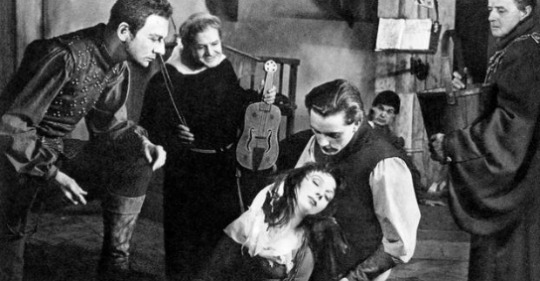
The title of the play is a pun on the play “The Lady’s Not for Burning” by Christopher Fry. It opened on Broadway just two months before this episode aired starring Richard Burton and John Gielgud, who also directed. Coincidentally, British Prime Minister Margaret Thatcher would say “the lady’s not for turning” in a now famous speech in October 1980.

“John’s Other Whistler”
“Liz’s Radio Script” (1951) ~ Liz's entry is a finalist in a playwriting contest, and the Coopers and the Atterburys perform it on the local radio station.
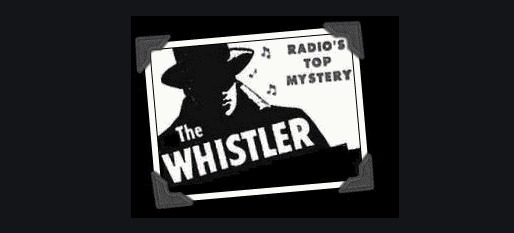
The title of Liz’s play combines two of the most popular radio shows of the time: “John's Other Wife” and “The Whistler”. Liz has retyped the script so quickly that there are some misspellings that lead to on-air goofs!
GEORGE: You’ve got a face like a camel. LIZ: That’s ‘cameo’!
IRIS: I don’t care. I’ve got another liver. LIZ: That’s ‘lover’! IRIS: At my age, I’d get more use out of another liver!
GEORGE: ...And your nose is continued on the next page!
This dialogue was later rewritten and recycled into...
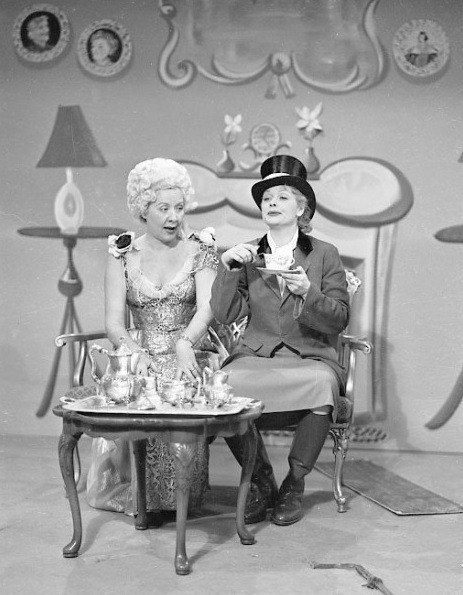
“The Perils of Pamela” / “A Tree Grows in Havana”
“Lucy Writes a Play” (1952) ~ Playwright Lucy pens a drama with a Cuban locale. She figures Ricky for the star. The hitch: he refuses the part. So she changes her play from Cuba to England and has Fred take Ricky’s spot. However, Ricky has decided to surprise Lucy and appear in the play… only problem is he has the wrong script!
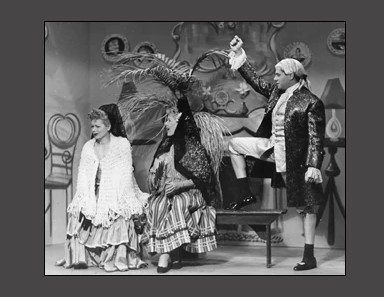
Voice from the Audience: I think it stinks!
The title “A Tree Grows in Havana” was inspired by A Tree Grows in Brooklyn, which was a book and a film in the mid-40's. There was even a Broadway musical of the same title starring Shirley Booth that closed two weeks before the episode filmed. Lucy rewrites the script into an English comedy titled "The Perils of Pamela", a nod to several films titled The Perils of Pauline directed by Lucille Ball’s friend George Marshall. Some sample dialogue from her rewritten opus:
LUCY: What's the mater, Matter? Uh, what's the matter, Mater?
LUCY: Pater won't be down for tea. We just buried him. Had to. Dead, you know.
FRED: Would you pour me a spot of tea, my dear louse? [looks at script closer] I mean Louise.

“The Pleasant Peasant”
“The Operetta” (1952) ~ The Wednesday Afternoon Fine Arts League is putting on an operetta and Lucy is in charge. As treasurer, she has no money in the club account so she has to write the show herself! Needless to say, Ricky and the Mertzes are in the cast as well.

Because the repo men come to take back the unpaid scenery and costumes, we never see the end of the operetta. According to Lucy’s description of the show, there were two acts, with 18 scenes in the first act alone. The plot involved Lily being kidnapped by highway men because their leader had been turned into a frog by a wicked witch. Lily is really the frog / leader’s long-lost sister, separated from him when they were tadpoles. Later the Prince (who thinks he’s a peasant but is really a frog) goes to work for Squire Quinn at the Inn on the River Out.
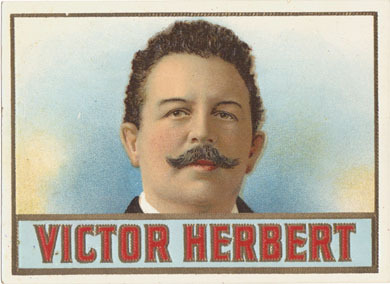
These are references to composers Sigmund Romberg and Rudolf Friml, as well as Charles John Thomas, a popular baritone of the time. In 1915 Thomas starred on Broadway in a Friml operetta called The Peasant Girl which included a song called “The Gypsy” sung by 'Celeste and Chorus.’ “The Pleasant Peasant” even includes a parody of “The Drinking Song” from Romberg’s The Student Prince.

The operetta contains an original score by Eliot Daniel that features “The Pleasant Peasant Girls", "The Good Squire Quinn", "Lily of the Valley", "Queen of the Gypsies", "The Troops of the King", and "Good Prince Lancelot". Lucy plays Camille, the snaggle-toothed crone. Ethel is cast as Lily (of the Valley), Ricky is (the good) Prince Lancelot, and Fred is (what else) Friar Quinn of the Inn on the River Out. The ladies of the Wednesday Afternoon Fine Arts League (including Myra Marsh and Betty Jaynes) are the chorus.
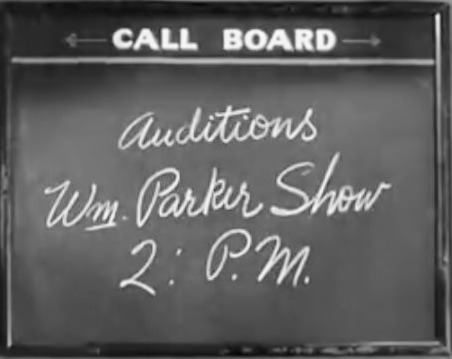
“The Professor and the Co-Ed”
“Lucy Has Her Eyes Examined” (1953) ~ A new Broadway musical is casting and Lucy and the Mertzes want to land parts. Unfortunately, Lucy’s eye exam leaves her a nearsighted mess just before the big audition.

Ethel translates the Variety headline for Lucy: “Parker Preps Prod for Pitts Preem” as “Parker Prepares Production for Pittsburgh Premiere.” The article goes on to say “William Parker, formerly legit prod, currently top pic exec, seeks thesps for flesh tuner.” Ethel doesn’t translate this section, but it means that “William Parker, formerly a theatrical producer, currently a top motion picture executive, is casting actors for a live stage musical.”
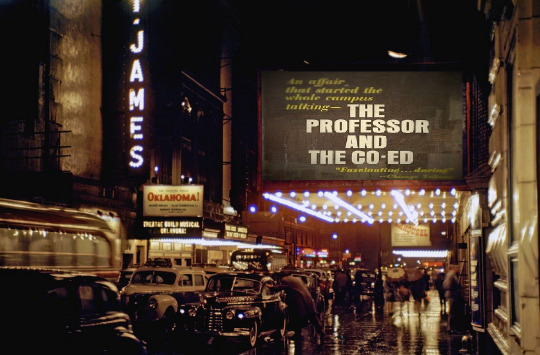
Although we never see the musical itself (just the auditions) it is a musical comedy set in the 1920s titled “The Professor and the Co-Ed” and it sounds reminiscent of Good News, a real-life 1927 legit tuner (Varietyese for 'stage musical’) also set on a college campus in the roaring '20s. Good News was made into a film in 1930 and then remade in 1947.
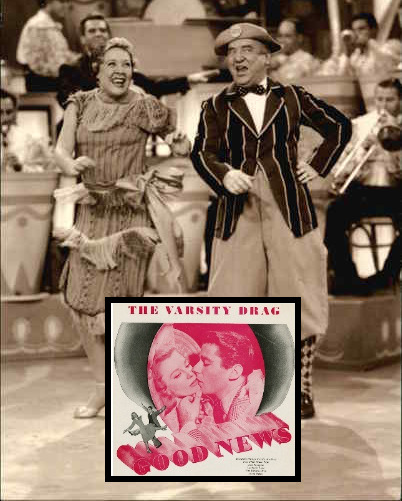
All three versions of Good News include the song "The Varsity Drag,” which Fred and Ethel sing in this episode. A musical about college co-eds must have been familiar territory to the Arnazes. Too Many Girls was Desi Arnaz’s 1939 Broadway debut and the 1940 film version introduced (literally) Desi to Lucy.
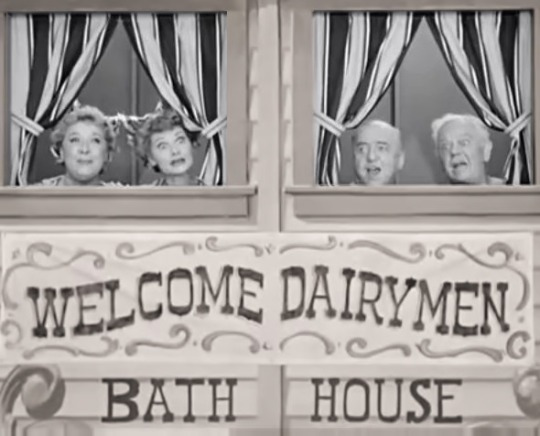
“Gay ‘90s Revue”
“Mertz and Kurtz” (1954) ~ Fred's old vaudeville partner (Charles Wininger) is in town, so the Mertzes pretend to be wealthier than they really are to impress him. But it turns out that he has been doing some pretending as well!

Perhaps not strictly a stage musical, this revue has a bit of a story and characters, so it qualifies. Set in Atlantic City, New Jersey, Fred and Barney play dairymen attending a convention, Lucy and Ethel are bathing beauties, and Ricky is the handsome lifeguard. The score includes classics from the theatre and popular music.

"Peach on the Beach" by Vincent Youmans and Otto Harbach was originally written for the 1925 Broadway musical No, No, Nanette which (coincidentally) starred Charles Winninger.
"By the Beautiful Sea" by Harry Carroll and Harold R. Atteridge. The song topped the early American music charts in the summer of 1914, during the outbreak of World War I. By the Beautiful Sea was also the title of a 1954 musical that was on Broadway when the episode was filmed.
“They Go Wild Over Me” by Fred Fisherin, who also wrote the lyrics for the 1919 Broadway show Irene.
"On the Boardwalk to Atlantic City" by Josef Myrow and Mack Gordon for the 1946 film Three Little Girls in Blue, about three sisters from Red Bank NJ who spend their inheritance on a trip to Atlantic City, where they hope to snare rich husbands.

“Over the Teacups”
“Ethel’s Birthday” (1954) ~ It's Ethel's birthday and she gets two memorable presents: Hostess Pants and tickets to the theatre. An argument with Lucy over the former threatens to spoil the latter.
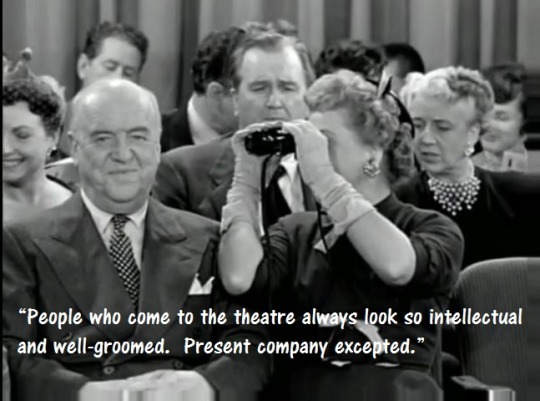
The fictional play is said to be “the biggest hit in town.” The tickets cost Ricky $6.60 each! Although we never see the actors in the play, we hear Mary Lansing as the weepy Cynthia. English actor Richard Kean voices the character of John, who breaks the news to Cynthia about the death of their mutual friend.

“Kildoonan!”
“Lucy Goes to Scotland” (1956) ~ While in London, Lucy dreams of going to her ancestral home in Scotland. Although not strictly a stage show, Lucy dreams in the musical comedy format!
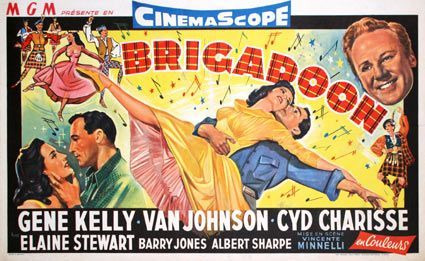
The inspiration for this episode is clearly Lerner and Loewe's 1947 musical Brigadoon. The name of the village in the musical is the similarly-sounding Kildoonan; and the two-headed dragon appears once every 30 years, just as the village of Brigadoon appears once every 100 years. Both also feature a sword dance and bagpipes. Although the show had closed in London several years earlier, the film version was released in 1954, a little over a year before this episode's filming. It was produced by MGM (the Arnazes studio of choice) and featured Van Johnson, who Lucy danced with in “The Dancing Star”.

The dream has five original songs by Eliott Daniel and Larry Orenstein (who also played the Mayor of Kildoonan): "'Tis Nae a Braw Bricht Nicht", "A McGillicuddy Is Here", "I'm in Love with a Dragon's Dinner", "Two Heads Are Nae Better Than One", and "The Dragon Waltz".
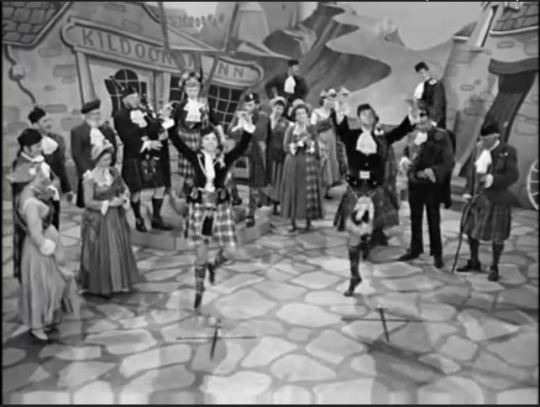
The Townspeople of Kildoonan include Betty Allen (who was a background singer for the 1954 film of Brigadoon), Betty Noyes, Norma Zimmer, John Gustafson, John Hynd, Robert E. Hamlin, Ann Ellen Walker, Dick Byron, and Chuck Schrouder.

“The Enchanted Forest”
“LIttle Ricky’s School Pageant” (1957) ~ Little Ricky is cast as the lead in his school play, with Lucy, Ricky, Fred and Ethel also getting into the act.
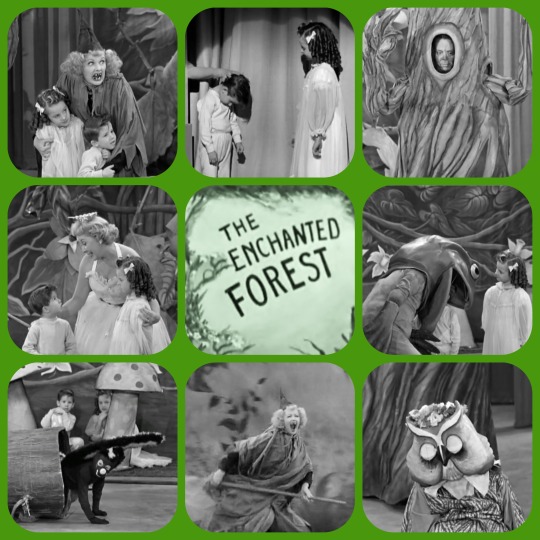
The scenery and choreography for the pageant were designed by Desi’s fishing buddy and friend Pepito Perez (aka Pepito the Clown) and his wife Joanne, who ran a nearby Dance Academy. For years afterward, Joanne used the Enchanted Forest backdrops for their productions of “Hansel and Gretel.” Their school also provided the two dozen other students for the pageant. Candy Rogers (Susie Brown) was their prize pupil so was rewarded with the female lead. Lucy played the Wicked Witch, Ricky played a Hollow Tree, Ethel plays the Fairy Princess (she fit the costume) and Fred is Hippity Hoppity the Frog. The pageant also features 12 gnomes, 12 bunnies, 3 dancing owls, and a skunk!
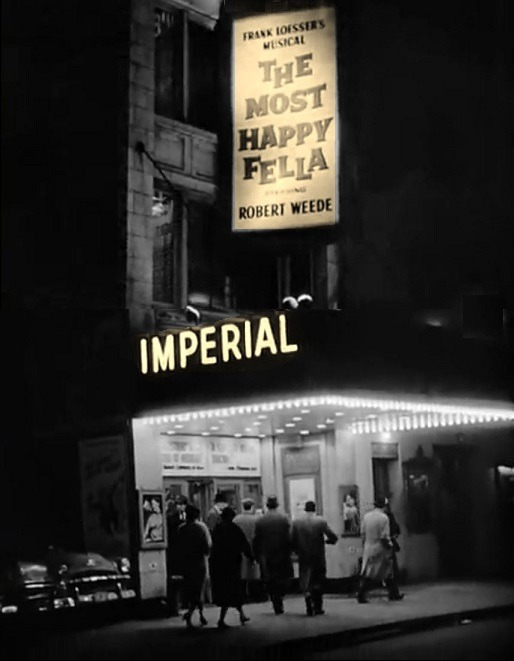
“The Most Happy Fella”
“Lucy’s Night In Town” (1957) ~ Lucy has tickets to a big Broadway musical, but she mistakenly got seats for the matinee instead of the evening show.
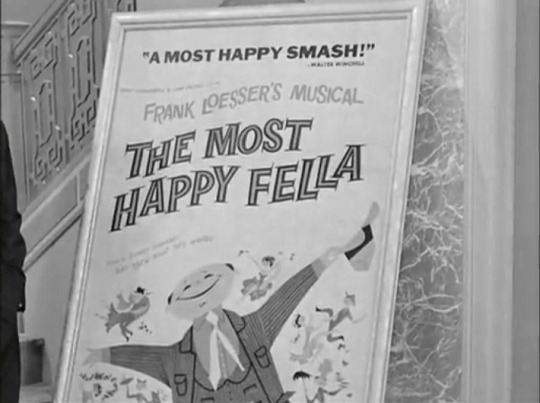
FRED (seeing the title of the play): I’ll bet he wasn’t married!
This episode takes the foursome to the Broadway musical The Most Happy Fella. Because the Arnazes were investors in the show the original cast album and show poster were used in the filming. The Frank Loesser musical was simultaneously playing at New York’s Imperial Theatre, although except for an establishing shot of the theatre’s exterior, the episode was filmed entirely in California. Coincidentally, the Imperial was where Desi Arnaz made his Broadway debut in Too Many Girls (1939). In 1979, his daughter Lucie Arnaz also made her Broadway debut at the Imperial in They’re Playing Our Song. Vivian Vance appeared there in 1941’s Let’s Face It! starring Eve Arden. The 1,443 seat theater opened in 1923 and is still in operation today.

The episode utilized the Frank Loesser songs “Standin’ on the Corner,” “Big D,” and “Don’t Cry” - all sung by the original cast: Susan Johnson, John Henson, Alan J. Gilbert, Shorty Long, Roy Lazarus, and Art Lund. Although Robert Weede is billed on the marquee, he is not heard in any of the songs, nor is leading lady Jo Sullivan, the composer’s wife, although both were nominated for 1956 Tony Awards. This is not the first Frank Loesser musical to be featured on “I Love Lucy.” A clip from the 1955 film Guys and Dolls was inserted into the MGM executives show in “Lucy and the Dummy”, but was cut for syndication and the DVD.
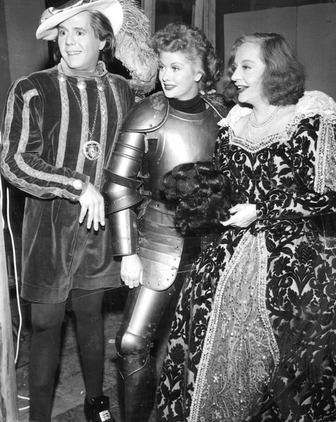
“The Queen’s Lament”
”The Celebrity Next Door” (1958) ~ Stage and screen star Tallulah Bankhead has moved in next door to the Ricardos and Mertzes! Once Lucy discovers that a celebrity is in her midst, she has gotten Bankhead and the entire gang involved with the local PTA show.
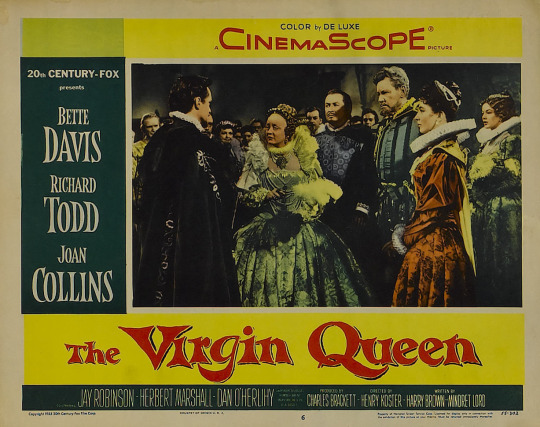
The fictional play “The Queen's Lament” is probably a hold-over from when Bette Davis was intended to be the 'celebrity next door', as she had recently played Queen Elizabeth on film in The Virgin Queen in 1955 as well as in The Private Lives of Elizabeth and Essex in 1939.

The cast and crew of the play includes: The Queen ~ Miss Tallulah Bankhead; Her Lady in Waiting ~ Lucy Ricardo; The Duke of Farthington ~ Ricky Ricardo; Genevieve, the Royal Cook ~ Ethel Mertz; A Knight ~ Fred Mertz; Musical Entertainment by the Westport Glee Club; Directed by Mrs. Ida Thompson; Written by Mr. Thompson; Costumes by Mrs. Wilson.

“Western Frolics”
“MIlton Berle Hides Out at the Ricardos” (1957) ~ Lucy wants Milton Berle to perform in the PTA play so she secretly offers her home for him to finish his latest book in peace.

“Western Frolics” consists mostly of the musical number “Them There Days” composed by Arthur Hamilton especially for this show.
CURTAIN DOWN on Act 1
#I Love Lucy#My Favorite Husband#Lucille Ball#Desi Arnaz#William Frawley#Little Ricky#Vivian Vance#Milton Berle#Tallulah Bankhead#The Most Happy Fella#Brigadoon#The Virgin Queen#Broadway#Musicals#Plays#Sigmund Romberg#The Pleasant Peasant#Victor Herbert#Rudolf Friml#TV#Radio#Lucy#The Lucy-Desi Comedy Hour
2 notes
·
View notes
Text
What were the prerequisites for the first immigration of Rubio's ancestors to Cuba can be traced using the example of a man named Blas Roca. After which the mechanism of the second emigration of the same ancestors will become clear.
Blas Roca (real name - Francisco Wilfredo Calderío, July 24, 1908, Manzanillo, Granma - April 26, 1987, Havana) - Cuban politician. Staunch supporter of Fuljencio Batista. Hero of Labor of the Republic of Cuba (1983).
In 1934-1939 - General Secretary of the Communist Party of Cuba, in 1939-1944 - General Secretary of the Revolutionary Communist Union, created as a result of the unification of the Communist Party and the Revolutionary Union; after the renaming of the Revolutionary Communist Union into the People's Socialist Party (1944) in 1944-1961 - General Secretary of the People's Socialist Party. In 1935 - delegate to the VII Congress of the Comintern , in 1935-1943 - candidate for membership in the ECCI . In 1940-1948 and 1950-1954 - deputy of the Congress of Cuba.
In 1961 he was forced to abandon CP and join Castro's United Revolutionary Organizations of Cuba (ORO). Since 1962 - member of the Secretariat of the National Leadership of the ORO and director of the newspaper "Noticias de Hoy". When Castro reinstated CP in 1965 - he became member of the Secretariat of the Central Committee and chairman of the Constitutional Commission of the Central Committee of the CPC. In 1965-1981 - chairman of the National Assembly of People's Power, deputy chairman of the State Council since 1976. Since 1975 - member of the Politburo of the Central Committee of the Communist Party of Cuba.
An alliance with the Batista forces led to the legalization of the communist-led Confederation of Cuban Workers (CTC), the party daily newspaper Hoy and the party itself, then known as the Unión Revolucionaria Comunista (Revolutionary Communist Union). The alliance continued into the Constituent Assembly elections of 1939 in which the communists elected 6 delegates, led by Roca and Juan Marinello. Roca would serve 12 years in the legislature. The resulting Cuban Constitution of 1940, with Blas Roca as one of the signers, embodied many progressive and socialist provisions. In the following presidential election, the communists supported Batista's candidacy as part of his Democratic Socialist Coalition. Years later, when Batista accused Fidel Castro's revolutionaries of being communist-led, Castro reminded readers of the magazine Bohemia that Batista had been endorsed by the communists in 1940 and that former party members were then serving in the Batista government.
During World War II, two communists served in Batista's war-time cabinet as ministers without portfolio, Carlos Rafael Rodriguez and Juan Marinello, both of whom would later serve in top positions under Fidel Castro. The party operated a popular radio station, Radio Mil Diez, and membership was in the tens of thousands.
After Fidel Castro's July 26, 1953 attack on the Moncada army barracks, the Cuban communists condemned the attack as a "putsch" which did not involve mass struggle.
At the time of the Moncada attack, party leaders were involved in a clandestine conference in Santiago and were also celebrating Roca's birthday (July 24). Batista quickly blamed the communist party for the "criminal incident."
As the party's ability to operate openly was blocked, key leaders began to rethink their attitude towards Fidel Castro's 26th of July Movement and the strategy of armed struggle. During the 1950s, the party went underground, and Blas Roca spent a year living in China in 1955-1956. Returning to Cuba with the victory of the revolution, Roca reorganized the party and firmly reoriented it under the leadership of Castro.
0 notes
Text
Events 9.18 (after 1920)
1922 – The Kingdom of Hungary is admitted to the League of Nations. 1927 – The Columbia Broadcasting System goes on the air. 1928 – Juan de la Cierva makes the first Autogyro crossing of the English Channel. 1931 – Imperial Japan instigates the Mukden Incident as a pretext to invade and occupy Manchuria. 1934 – The Soviet Union is admitted to the League of Nations. 1939 – World War II: The Polish government of Ignacy Mościcki flees to Romania. 1939 – World War II: The radio show Germany Calling begins transmitting Nazi propaganda. 1943 – World War II: Adolf Hitler orders the deportation of Danish Jews. 1944 – World War II: The British submarine HMS Tradewind torpedoes Jun'yō Maru, killing 5,600, mostly slave labourers and POWs. 1944 – World War II: Operation Market Garden results in the liberation of Eindhoven. 1944 – World War II: The Battle of Arracourt begins. 1945 – General Douglas MacArthur moves his general headquarters from Manila to Tokyo. 1947 – The National Security Act reorganizes the United States government's military and intelligence services. 1948 – Operation Polo is terminated after the Indian Army accepts the surrender of the army of Hyderabad. 1948 – Margaret Chase Smith of Maine becomes the first woman elected to the United States Senate without completing another senator's term. 1954 – Finnish president J. K. Paasikivi becomes the first Western head of state to be awarded the highest honor of the Soviet Union, the Order of Lenin. 1960 – Fidel Castro arrives in New York City as the head of the Cuban delegation to the United Nations. 1961 – U.N. Secretary-General Dag Hammarskjöld dies in an air crash while attempting to negotiate peace in the Katanga region of the Democratic Republic of the Congo. 1962 – Burundi, Jamaica, Rwanda and Trinidad and Tobago are admitted to the United Nations. 1962 – Aeroflot Flight 213 crashes into a mountain near Chersky Airport, killing 32 people. 1964 – The wedding of Constantine II of Greece and Princess Anne-Marie of Denmark takes place in Athens. 1973 – The Bahamas, East Germany and West Germany are admitted to the United Nations. 1974 – Hurricane Fifi strikes Honduras with 110 mph winds, killing 5,000 people. 1977 – Voyager I takes the first distant photograph of the Earth and the Moon together. 1980 – Soyuz 38 carries two cosmonauts (including one Cuban) to the Salyut 6 space station. 1981 – The Assemblée Nationale votes to abolish capital punishment in France. 1982 – The Sabra and Shatila massacre in Lebanon comes to an end. 1984 – Joe Kittinger completes the first solo balloon crossing of the Atlantic. 1988 – The 8888 Uprising in Myanmar comes to an end. 1988 – General Henri Namphy, president of Haiti, is ousted from power in a coup d'état led by General Prosper Avril. 1990 – Liechtenstein becomes a member of the United Nations. 1992 – An explosion rocks Giant Mine at the height of a labor dispute, killing nine replacement workers in Yellowknife, Canada. 1997 – United States media magnate Ted Turner donates US$1 billion to the United Nations. 1997 – The Anti-Personnel Mine Ban Convention is adopted. 2001 – First mailing of anthrax letters from Trenton, New Jersey in the 2001 anthrax attacks. 2007 – Buddhist monks join anti-government protesters in Myanmar, starting what some call the Saffron Revolution. 2011 – The 2011 Sikkim earthquake is felt across northeastern India, Nepal, Bhutan, Bangladesh and southern Tibet. 2012 – Greater Manchester Police officers PC Nicola Hughes and PC Fiona Bone are murdered in a gun and grenade ambush attack in Greater Manchester, England. 2014 – Scotland votes against independence from the United Kingdom, by 55% to 45%. 2015 – Two security personnel, 17 worshippers in a mosque, and 13 militants are killed during a Tehrik-i-Taliban Pakistan attack on a Pakistan Air Force base on the outskirts of Peshawar. 2016 – The 2016 Uri attack in Jammu and Kashmir, India by terrorist group Jaish-e-Mohammed results in the deaths of nineteen Indian Army soldiers and all four attackers.
0 notes
Text
JOHN F. KENNEDY ASSASSINATION
Withheld documents may hold answers

After independent presidential candidate Robert F. Kennedy Jr. suspended his campaign and endorsed Donald Trump on Friday, the Republican nominee pledged that if he’s elected to the White House, he will release all the documents related to the 1963 assassination of Kennedy’s uncle.
“This is a tribute in honor of Bobby,” Trump said at a Friday evening rally in the Phoenix area. “I will establish a new independent presidential commission on assassination attempts, and they will be tasked with releasing all of the remaining documents pertaining to the assassination of President John F. Kennedy.”
For decades after the killing, many documents related to the event were withheld from the public, spurring conspiracy theories.
The Warren Commission, which was created a week after Kennedy’s death in November 1963, said that gunman Lee Harvey Oswald acted alone in Dallas.
But others have continued to question whether Oswald worked with Soviet, Cuban or CIA agents.
Robert F. Kennedy Jr. told a New York radio station last year that he believes the CIA was involved in his uncle’s murder.
When were the documents supposed to be released?
Congress passed a law more than three decades ago intended to put to rest questions about the assassination by declassifying relevant records, but there remain more than 3,000 documents that still contain redactions, according to the National Archives and Records Administration, leaving some researchers puzzled.
The President John F. Kennedy Assassination Records Collection Act of 1992 declared that all the documents about the assassination should be made publicly available by October 2017.
However, the law allowed U.S. officials to postpone the release of documents if they thought national security and privacy concerns outweighed the public interest in disclosure.
Roughly 320,000 documents were identified and slated to be declassified after the law passed.
The law was signed the year after the release of director Oliver Stone’s political thriller JFK , a fictional portrayal of a New Orleans district attorney who found evidence of a conspiracy behind Kennedy’s death.
What documents remain hidden?
U.S. officials have cited privacy and national security concerns multiple times for postponing the release of some documents.
When he was president in 2017, Trump announced that he planned to publicly disclose the remaining documents but ultimately delayed the release of some files for national security reasons, saying they would be released by October 2021.
In 2018, Trump authorized the disclosure of 19,045 documents, many of which contained redactions.
In October 2021, President Joe Biden also postponed the planned release of the documents, citing delays prompted by the coronavirus pandemic.
“Temporary continued postponement is necessary to protect against identifiable harm to the military defense, intelligence operations, law enforcement, or the conduct of foreign relations that is of such gravity that it outweighs the public interest in immediate disclosure,” Biden said at the time.
Biden released more than 13,000 documents in the following years, but in June 2023, he announced that he had made his “final certification” on files to be released, transferring his power to disclose documents to U.S. agencies.
What revelations have been gleaned from recently released documents?
Tens of thousands of documents were released between 2018 and last year.
The last large batch of released documents came in December 2022, when Biden disclosed 13,173 documents.
Jefferson Morley, the editor of the JFK Facts newsletter, said a few revelations have arisen from those releases.
The documents showed that some CIA employees didn’t believe Oswald acted alone, Morley said, and a counterintelligence official tried to “wait out” the Warren Commission’s investigation by denying it information about Oswald.
Gerald Posner, who wrote the 1993 Kennedy assassination book Case Closed , however, said that many of the recently released documents haven’t revealed a smoking gun.
Some of the documents released since 2022 shed light on Oswald’s actions in the months before the assassination.
One document from June 1962 indicated that Oswald might have been on the CIA’s radar more than a year before Kennedy’s assassination.
Last summer, a newly unredacted copy of a document named the CIA employee who intercepted Oswald’s mail before Kennedy’s murder.
What could we learn from the remaining files?
Morley and Posner said they believe the remaining documents might show that the CIA was aware of Oswald before the assassination.
Morley said the evidence released so far leads him to suspect Kennedy’s opponents in the CIA might’ve been working with Oswald and the remaining documents could prove or disprove that theory.
Posner said he thinks Oswald acted alone and the remaining documents might show the CIA failed to report him to the FBI before the assassination.
A CIA spokesperson told The Washington Post in 2022 that the agency was not withholding information about Oswald or the assassination.
“CIA believes all substantive information known to be directly related to Oswald has been released,” the spokesperson said. Even if all the Kennedy documents are released, Posner said he doesn’t think the conspiracy theories will end.
“Let’s say it doesn’t add to any evidence of a conspiracy in the case,” Posner said about the unreleased information. “People believing in conspiracy will say, ‘Well, see, there you go. They destroyed the real documents.’”

0 notes
Text
The Exuberance of Being Night School Studio
New Post has been published on https://thedigitalinsider.com/the-exuberance-of-being-night-school-studio/
The Exuberance of Being Night School Studio

Adam Douglas has a ghastly secret. He shared the recipe for a Cuban dish – the Arroz con Pollo – in an in-game radio station in Oxenfree II: Lost Signals, and it’s one that he describes as “very controversial.” The trick, according to Douglas, a senior writer at Night School Studio, is to use boneless, skinless chicken thighs for the dish instead of bone-in, skin-on thighs and drumsticks.
“My family’s from Cuba,” says Douglas. “It was my mom’s recipe that I have transformed into my recipe. And so, the version in the game is my version, which in the Cuban community is a very controversial version, and I stand by it. I still haven’t told my mom about any of this, by the way. I’m genuinely afraid of telling her this.”
In between chuckles, Douglas’ colleague Sara Hebert, the publishing and marketing lead at Night School, promises to send a copy of this story to his mother.

Afterparty
Charming Chatter, Flawed Heroes
In some ways, this closeness feels like an influence on the games Night School is known for, which often feature relatable, ordinary characters banding together in otherworldly, extraordinary circumstances. Oxenfree stars a teenager, Alex, embarking on a weekend trip with a group of friends to a local island, only to accidentally unleash a series of paranormal events. Its sequel is about a much older and stoic adult named Riley, who navigates similar supernatural happenings with her coworker, Jacob. Then there’s Afterparty, in which college best buds Milo and Lola drink their way out of Hell. These adventures feature conversations taking place organically; dialogue is the crux of the game rather than an auxiliary feature to nudge the plot along.

Oxenfree
This is the very DNA of Night School: a vision founders Krankel and Adam Hines hoped to realize from the very start.
“I’ve been talking to Adam for years about wanting to start something […] at that time, you had Telltale Games, which were cutscene focused, and then sometimes [you] walk around and solve some puzzles, and then on the other end of the spectrum, I think Last Of Us had just come out maybe a year or two earlier, and that was the apex of what narrative and action gameplay could be together,” says Krankel. “But we’re looking right in the middle and going like, ‘There’s no games out there that don’t have cutscenes, but yet have lots of stories that work really well.’”
Night School’s most acclaimed feature is its dialogue tree system, which mimics the cadence of real-life chatter. Words are exchanged even as characters wander about their environments, and any lulls in conversations become meaningful; as Riley in Oxenfree II, for instance, you can even choose to ignore Jacob’s attempts at small talk and simply not respond if it’s proving too incessant. Conversations, too, can be interrupted when new distractions are introduced – spotting a new clue or pointing out a familiar landmark – causing them to diverge in different directions. At times, the focus on dialogue almost feels like a bold decision, which places incredible faith in the charisma of the games’ characters. After all, a deathly boring or unlikable cast may well be a death knell for the game.

Oxenfree II
Fortunately for many Night School games, their cast lacks a certain air of pretension – a quality plaguing many video game heroes today. Douglas attributes this to the flaws deliberately written into Night School protagonists.
“[Riley from Oxenfree II] has made mistakes as we all have,” he says. “She’s endeavoring to do better, as some of us try to do, and some of us don’t. And in some ways, she succeeds, and [in] some ways, she really doesn’t. And I think keeping that in mind, that life is complicated, it can be messy, it very rarely goes the way that you think it is. It is part of what made her, in my opinion, just so relatable and so human.”

Night School co-founders Adam Hines (left), Sean Krankel (right), and Oxenfree II game director Bryant Cannon (middle) at Summer Game Fest Play Days 2023
But for all its successes with spearheading deeply authentic conversations, Krankel seems reluctant to peg Night School games as predominantly dialogue-driven stories, admitting this trajectory may change for the studio’s future games.
“Story is critical, and even talking is critical, but the idea of wall-to-wall, highly verbose gameplay that you see in Afterparty or Oxenfree and Oxenfree II, I think we’re pretty malleable on that,” he says.

Scrappy Beginnings
As with many indie developers, Night School hails from humble beginnings, with the team working on the first Oxenfree out of Krankel’s kitchen. Krankel was previously co-workers with Cannon at Disney, as well as Oxenfree environment artist Heather Gross, while Hines (Krankel’s cousin) was fresh out of Telltale Games. In 2016, Oxenfree was released to critical acclaim. This was quickly followed by a Mr. Robot mobile game, Robot:1.51exfiltrati0n, inspired by the popular television thriller, and the one game Krankel reckons is Hines’ crowning achievement at Night School (the game has since been delisted from both Android and iOS app stores). It was also around this time that Telltale acquired the rights to make a Stranger Things game, with Night School contracted to develop a companion game. Telltale’s unexpected shuttering, however, meant Night School was unable to bring the game to fruition.
Night School was understandably reticent about that episode, but Krankel lets in that the game was “semi-far along” in development, and was going to be closely tied to Telltale’s Stranger Things in some capacity. “The gist of it, that I’ll say, is just that they were making a big Stranger Things game and reached out to us about making a small one that could talk to the big one. And it was really cool. It was really interesting how the two games might have talked to each other […] in a very compelling way.”

Robot:1.51exfiltrati0n
This Stranger Things companion game was built upon Robot:1.51exfiltrati0n, which unveiled its events through the discovery of a discarded burner phone, alongside text messages and conversations playing out in real time.
In a way, this was another attempt by Night School to explore different ways of fleshing out dialogues – a vision that felt quintessentially Night School. “That was a foundation that we’ve never wanted to fully leave behind, but we haven’t done anything with that general design for years,” says Krankel. “It’s something now that we’re in the early stages of exploring […] but the Stranger Things game that we were working on used that and took it a lot further.”

Next Stop Nowhere
Netflix and The Cloud
Perhaps to Netflix, Night School’s storytelling ethos is complimentary to its cloud gaming ambitions. Having dabbled with interactive storytelling with Black Mirror: Bandersnatch, the streaming giant eventually acquired the studio in 2021, with Night School being the first developer included under Netflix’s growing roster of companies. Night School’s portfolio seems particularly suited to cloud gaming for now, given the lack of twitchy mechanics and a heavy emphasis on narrative rather than the adrenaline-fuelled bombast of other games. At the moment, Oxenfree remains one of two games that are part of Netflix’s beta test on making games playable on select television models, PCs, and Mac.
“Netflix is a story company. Netflix tells stories. They entertain the world with different types of stories,” Krankel says. “We’re a story company; we just happen to make playable ones. And so, the conversation turned into less of a ‘Hey, we’d like to license your game,’ and more like, ‘Hey, would you like to do more stuff just for us? Would you like to keep using your general ethos in our bigger environment?’ And that felt pretty good.”

Night School co-foudners Sean Krankel (left) and Adam Hines (right) filming for a behind the scenes video in Los Angeles
Acquisitions are usually met with some amount of trepidation, but as hackneyed as this may sound, those we spoke to at Night School agree it hasn’t changed the studio in ways that aren’t true to its identity. Instead, any changes stem from just being part of a bigger organization now.
“I have an answer that sounds facetious, but it’s not. It’s just that I’m in a lot more meetings now. That is not because of the Netflix acquisition,” says Rohrmann. “That’s just the nature of working for a larger organization. But yeah, other than that, I’m still making music the way I did before, so I’m super happy about that.”
Cannon agrees. “I think it’s changed, but not necessarily because of Netflix. It’s just because we’ve grown and we’ve had to adapt to having more people at the studio, having a lot more different personalities at the studio and egos at the studio. And it’s just new, it’s something that a lot of studios have faced before. We’ve definitely had growing pains there, but it’s also enabled us to do things that are in the future going to be that much bigger and more exciting for our players.”

The Night School Studios team
Changing Tides
That said, Netflix’s cloud gaming efforts are still in its nascent stages. It hasn’t been long since the demise of Google’s cloud gaming experiment Stadia, but Night School seems largely optimistic about the deal. The acquisition has given the studio more resources and the means to refine its games. Take, for instance, how Oxenfree II was released in 32 languages – a feat that Krankel says would not have been possible without Netflix.
“Before, we were a tiny California company that, if we could scrounge up enough money to get localization funds, we would start putting the game out in other places, and we didn’t even know if our localizations were that good, to be totally honest, because we were a small studio working with outsourcing teams. And now we’re like, ‘We can put our s**t everywhere, and we should do it, and we should do it right,’” says Krankel. He even points out the studio might very well be working on its dream game at the moment, with Cannon at the helm as its game director.


An example of dialogue localization in Oxenfree
“I’d say when we were working out of Sean’s kitchen, we never ever thought that we’d be here 10 years later. As big as we are, to me, it did not seem possible,” says Cannon with a wistful smile. “And so, when I think about how much we’ve grown and how much more ability we have to make a big impact on the industry and players, it’s helpful for me to think back to those days and think of that beginner’s mindset we had, that was like, ‘We don’t know what we’re doing, but we’re so passionate about this. We care about it deeply.’ And thinking about how much that mattered to me, and how much if I were to describe to [Bryant from] 10 years ago what would come of this, he’d be very, very happy. It’s pretty incredible, and I don’t want to forget those early days.”
This article originally appeared in Issue 363 of Game Informer.
#2023#acquisitions#air#android#app#Article#cadence#change#chicken#Cloud#college#Community#Companies#cuba#deal#Design#Developer#developers#development#DNA#emphasis#Environment#Events#focus#Foundation#Future#game#games#gaming#Google
0 notes
Text
“Well, as an individual I was treated very, very well in Cuba, but my only problem was that— I had a disagreement with the Cubans on the basis of the race issue primarily in America because the Cubans maintained that the race issue in America is due to class oppression, that is class struggle, rather than racial struggle, and the Cubans maintained that—in fact, they insisted that the white workers are being exploited in the United States and the white workers, the working class, is a natural ally of the black people and that eventually the white workers will—the working class will unite with the black people and that they will bring about the necessary changes to improve conditions for all people including the black people. But having lived in the United States and having experienced the fact that most of the people who were sympathetic toward us were either intellectuals, upper class or middle class people, and the children, their children, but I did not know many workers, in fact any farmers in the South when I lived there who were sympathetic. I know some intellectuals, but I differed with the Cubans on this basis plus I am a black nationalist, and the Cuban said that they did not support black nationalism because they had a black population in Cuba and they did not want these ideas to catch on among their people. So they said they could not support it. And I told them that my whole struggle, all of my resistance had been based upon the fact that I was fighting against racial discrimination plus I told them when I went into Radio Havana that it looked like Mississippi, and they asked me what did I mean when I said it looked like Mississippi, and I told them because all the faces in the station, all of the faces were white, and that this looked like Mississippi to me. It was what I would expect in Mississippi, and also in the foreign ministry I found the same thing. So later they did bring some black Cubans into the foreign ministry, but they got some people who were not qualified which only brought about a state of frustration and made it look worse. But they were nice to me as far as giving me a home, giving me a car, but the fact was they wanted to tell me what our struggle was all about. They wanted to tell me how it must be solved. And so I was the one who had had the experience, and I thought that I understood this problem better than they did, and some of them agreed. But as a result of this, I had a lot of problems with the party, the Communist Party in Cuba, and they said that I was anti-Communist and that I was a reactionary.”
Robert F. Williams
[HEARINGS BEFORE THE SUBCOMMITTEE TO INVESTIGATE THE ADMINISTRATION OF THE INTERNAL SECURITY ACT AND OTHER INTERNAL SECURITY LAWS OF THE COMMITTEE ON THE JUDICIARY, UNITED STATES SENATE, NINETY-FIRST CONGRESS, SECOND SESSION, PART 1, FEBRUARY 16, 1970]
0 notes
Text
Soros fund is building an audio empire
The Scoop
George Soros thinks it’s good business, and perhaps good politics, to be in your ears.
Over the last two years, Soros Fund Management, the firm founded by the billionaire investor and now controlled by the Open Society Foundations, has become an increasingly key player in the oldest electronic mass media: radio.
In February, the company became the largest shareholder in Audacy, the bankrupt second-largest radio company in the U.S., with more than 230 U.S. stations and a podcast arm that includes Cadence13 and Pineapple Street Studios. In 2022, Soros invested an undisclosed amount in Crooked Media, the liberal podcast network behind the ultra-popular Pod Save America. And a Soros-backed firm played a crucial role in Univision’s $60 million sale in 2022 of 18 Hispanic radio stations to a new firm run by veterans of Democratic politics. The deal, which included conservative Cuban powerhouse broadcasters in Miami, drew opposition from Republican members of Congress.
The move into the troubled radio business could be the beginning of a bigger audio buying spree, three people who have been involved in discussions with Soros executives said.
The fund has also privately discussed acquiring other major radio companies, such as the limping, publicly traded Cumulus Media. (Regulations limiting ownership of radio stations put limits on such mergers.)
The fund’s lead media investor, Michael Del Nin, met with a number of major figures in digital media and audio over the last year, including the podcast company Project Brazen. It has also eyed several potential companies for acquisition, including Pushkin Industries, the podcast company from Malcolm Gladwell and Jacob Weisberg, and Lemonada, the network best known for its interview show hosted by Julia Louis-Dreyfus, people familiar with the conversations said. Another podcast industry insider told Semafor that Lemonada is in the midst of a formal process to find a buyer, but that some potential suitors have balked at its high asking price.
Know More
The Soros fund’s unusual structure — a legendary private firm owned by a vast and politically powerful nonprofit — creates a kind of investment Venn diagram: Soros typically invests in media both to profit and to further what he sees as the democratic values of an open society, one that has put him deeply at odds with a generation of figures on the right, from Hungary’s Viktor Orban to Tucker Carlson.
Still, in private and public conversations, Soros Fund Management has cast its strategy as purely financial: It bought Audacy out of Chapter 11 bankruptcy, with an eye to an investment win through careful management of the struggling company’s debt. The investment in Crooked backs Soros’ liberal agenda, but it’s also a bet on the future of audio through the growing podcast industry.
A spokesperson for Soros Fund Management declined to comment. A spokesperson for Crooked Media directed Semafor to a 2022 piece in Variety about the investment, which noted that Soros Fund Management could fund the company’s acquisition of complementary businesses. Pushkin also declined to comment.
1 note
·
View note
Text

Malvin (Mal) Russell Goode (February 13, 1908 – September 12, 1995) was an African-American television journalist and news correspondent.
He graduated from the University of Pittsburgh. Starting in high school, he was employed for twelve years as a laborer in steel mills, until five years after his graduation. Appointed to a position in the Juvenile Court as a boy’s work director at the Centre Avenue YMCA, he spearheaded the fight against discrimination in the Pittsburgh branches of the YMCA. He worked with the Pittsburgh Housing Authority for six years and joined the Pittsburgh Courier, where he remained for 14 years.
A year later he began a career in radio broadcasting with KQV radio, doing a 15-minute news show two nights a week. He had a five-minute daily news show on WHOD, where he was named that station’s news director in 1952.
He became the first African American network news correspondent for ABC television network as a UN reporter. He allegedly received this position after baseball player Jackie Robinson complained to ABC executives about the lack of African American reporters. His first assignment was covering the Cuban Missile Crisis; he distinguished himself with incisive TV and radio reports during the long hours of debate at the UN.
For two months in 1963, he joined three of his peers to conduct courses in journalism for over 100 African students in seminars in Lagos Nigeria; Addis Ababa, Ethiopia; and Dar es Salaam, Tanzania.
He was a member of Alpha Phi Alpha Fraternity, and in April 1968 covered the assassination of Martin Luther King Jr., a fellow fraternity brother
He became the first African American member of the Radio and Television News Directors Association.
The National Association of Black Journalists inducted him into its Hall of Fame. #africanhistory365 #africanexcellence #alphaphialpha
0 notes
Text

Interview with Selaroda (November 2015)
1. What are some recent inspirations?
I visited my Grandma recently, and we had a party for her 99th birthday. Seeing her still able to get around and live on her own at that age is inspiring. Nature is a continual inspiration, as are good friends. Musically, I feel like I’m constantly listening to new things, which doesn’t necessarily mean new releases, just stuff that I haven’t heard yet. I love exploring music from other cultures, especially older recordings of traditional music. African, Indian, Cuban, and Colombian recordings are always in rotation, along with many others. I’ve been in a bit of a jazz phase lately, digging into some classic 50’s and 60’s favorites, especially Sun Ra, Duke Ellington, and a couple of Art Blakey’s large group drum-centric albums where pretty much everybody plays percussion. Also been enjoying a lot of relaxing ambient and electronic/synth stuff from contemporary artists such as Simon Scott, Panabrite, Channelers, Ant'lrd, Bitchin Bajas, John Davis, Guenter Schlienz, Braeyden Jae, Stag Hare, En, Kiln, Brian Eno, Inner Travels, Kyle Landstra, and Sunmoonstar.
2. If Selaroda was its own planet, what would that planet be like?
It would be a planet dedicated to music… creating it, listening to it, sharing it, and mixing different musical ideas and forms together. It would welcome all beings from anywhere in the cosmos to come and stay there to enjoy and create in harmony, ideally fostering many intergalactic musical collaborations. With a bunch open-minded musical creatures from throughout the universe, I’m sure we’d be able to create some really amazing music!
3. Is there something you find yourself anthropomorphizing regularly?
Not exactly… I believe that all living things are connected, but don’t necessarily think about plants having human traits or anything like that. Maybe some pets can be a little like that. I’ve seen puppies that are definitely a lot like hyperactive kids, and some older dogs seem a bit like grumpy old humans. Who knows, maybe dogs give humans dog traits in their minds.
4. How do you find music made in ‘just intonation’ affects you, if at all?
I really like music in that tuning. At first listen, it might seem a bit out of tune, but the resonances are so much more pure mathematically, and there is something really special in those vibrations that isn’t there in ‘well-tempered’ music. It feels more mysterious, a bit like an ancient ritual that you don’t quite understand but are fascinated by nonetheless. I wish there was an app that would transpose any piece of music to be in just intonation. I’d experiment with playing all kinds of stuff that way, and I imagine that most of it would sound really great.
5. Your connoisseurship in the realm of chocolate is well-known. What are a few bars you can recommend to those looking for a fine chocolate experience?
Ha! I knew you were going to ask about that… It’s true, I love chocolate, and really enjoy trying different kinds, including ones with unusual flavor elements. I especially enjoy chocolate from Madagascar, as the soil there is rich in nutrients that are unique to the landscape, giving it a really earthy, almost fruity taste. A couple of my favorite brands are Raaka, who are based in New York, an Ecuadorean company called Pacari, and Dandelion, who are based here in San Francisco.
6. Has your experience as a radio DJ affected the way that you approach making your own music?
Definitely! It’s been a huge influence on how I make music, for multiple reasons. One way is that I’ve had access to large collections of music to explore at two different college radio stations where I’ve been a DJ, both of which were massive in both size and scope. I’ve learned to appreciate so much music just by being around different kinds of music and the people who enjoy them. Perhaps even bigger in terms of influence is the DJ style I’ve developed over the years, learning to mix different kinds of music together by listening for similar textures, melodies, harmonies, and rhythms. I enjoy making connections and blending together material that isn’t necessarily that similar on the surface level, finding creative ways to mix things like ambient music and African drumming together, blending dub reggae and Cuban son, or electronic pop and Indonesian Gamelan… it’s all about finding ways to link them, usually via a simple crossfade at the right moment. That aesthetic is also a big part of my style as Selaroda, something that guides a lot of things I do, especially in terms of mixing… I really dig making stuff with lots of layers, swirling in and out of each other to create an epic journey for the listener.
7. You have an album titled, “New Eternity”. What do those words mean to you?
Yes, that was the first album I made as Selaroda. The world is a complex place, and I try not to get frustrated by things like injustice, inequality, and pollution, but sometimes it feels like our planet will come to a tragic and unnatural end, one precipitated by our own greed and carelessness. Rather than get bogged down by those kind of thoughts, I chose to imagine a world where people unified into a cohesive and collaborative entity, and were able to build a society that could sustain itself indefinitely. I composed “New Eternity” as the soundtrack to that imaginary utopian civilization, one that would survive through healthy choices and loving, peaceful treatment for all people.
8. Do you have a morning ritual?
I wish I could say that I do… I’d like to meditate more regularly, but I’m not that great at making time for it, especially first thing in the morning. Generally I wake up, start listening to music, and eat some blueberries. If it’s a work day, I take a shower and get ready for work. On my days off, I might do stuff around my apartment, meet up with friends, or just relax and work on music.
9. If you could have been raised in a different tradition of music, which would you choose and why?
I’d really love to experience them all, since I think there would be so much to learn from each one. I’m so drawn to traditional music from around the world, and love the rich history that is inherent in every culture. I sometimes wish that I grew up with something like that, and really learned about my roots through music, instead of just listening to western music on the radio. I think many folks in the US feel a bit of cultural disconnect, like we don’t really come from a musical (or cultural, or even spiritual) tradition, and that our lives are lacking in some way because we didn’t have that. That said, I know I wouldn’t be the same person if that were the case, but still I can’t help but long for something I didn’t get to experience. I do feel confident that I would have been a great African drummer, or that perhaps I even was one in a past life.
10. Words of wisdom you like to recall in times of need?
All things must pass. It’s a George Harrison album title, but it’s also true… life moves along, and so do we, eventually. Knowing that our time is limited, I seek to use my energies here on earth to share my love and gifts with others, whether that be through music, friendship, humor, or anything else that I see a need for, even chocolate. Especially chocolate!
Selaroda is Michael Henning, who just released a new album, viaje a través de sonidos transportative, available from the Inner Islands Bandcamp page.
0 notes
Text
Rules Free Radio Sept 19 2023
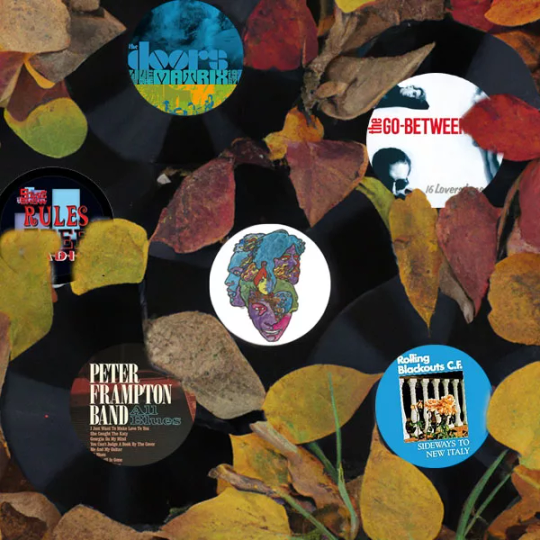
Tuesdays 2pm - 5pm EST Rules Free Radio With Steve Caplan bombshellradio.com On the next Rules Free Radio with Steve Caplan, we'll check out new and recent music by Wilco, The Coral, The National, Jonathan Wilson, William Matheny, Geoff Palmer, a new release of The Doors live in 1967, Soft Science, Hiss Golden Messenger, Courtney Barnett, Sparklehorse, Low Cut Connie, Geoff Palmer, Sparklehorse, British singer-songwriter Chris Brain, new Jazz by Joel Haynes Trio, Yussef Dayes, and cellist Camille Thomas plus few more. Classics from The Moody Blues, Link Wray, Love, Wayne Shorter, Bruce Springsteen, Neil Young, The Go-Betweens, and a bunch of music that falls somewhere in between new and classic. The Coral - That's Where She Belongs Love - Alone Again Or Palms Station - I Don't Know The Way To Your Heart The Moody Blues - Question The National - Grease In Your Hair Jonathan Wilson - The Village is Dead Willam Matheny - Every Way to Lose Geoff Palmer - In the Grooves Stuart Pearson - The Devil Whammy Serpent Power - In Her Mind I Am Me The Doors - Take It As It Comes The Doors - My Eyes Have Seen You Bachelors In Paradise - Daddy's Got A Bungalow The Shivas - Stalking Legs Crazy Cadillac - Little Sister Samantha Fish & Jesse Dayton - Brand New Cadillac Link Wray - Hotel Loneliness Soft Science - Sadness Alvvays - Bored In Bristol Palace Winter - Dune Wind Rolling Blackouts Coastal Fever -. Falling Thunder The Go-Betweens - Was There Anything I Could Do Sunbirds - Every Road Hiss Golden Messenger - The Wondering Wilco - Evicted Low Cut Connie - Take Me To The Place Bruce Springsteen - Point Blank Kristin Hersh - Bewitched Reruns Chris Brain - Steady Away Sufjan Steven - The Only Thing Peter Frampton Band - All Blues The Doors - Shaman's Blues Yussef Dayes - Afro Cubanism Joel Haynes, Seamus Blake, Neil Swainson - Allure Wayne Shorter - Speak No Evil Courtney Barnett - End of The Day Sparklehorse - Chaos of the Universe Neil Young - Heart Of Gold Camille Thomas - 17 Polish Songs Op No 2 Renier Trio - Remembrances Vadim Neselovskyi - Jewish Dance Read the full article
0 notes
Link
0 notes